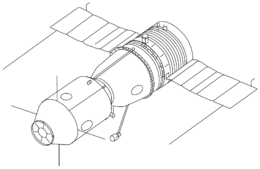Soyuz-A
 Soyuz 7K manned spacecraft concept (1963) | |
| Manufacturer | OKB-1 |
|---|---|
| Country of origin |
|
| Applications | Carry up to three cosmonauts to lunar orbit. |
| Specifications | |
| Regime |
Low Earth Medium Earth Circumlunar |
| Production | |
| Status | Cancelled |
| Launched | None |
| Related spacecraft | |
| Derivatives | Soyuz 7K-OK (first Soyuz generation to fly manned) |
Sergei Korolev initially promoted the Soyuz A-B-V circumlunar complex (7K-9K-11K) concept (also known as L1) in which a two-man craft Soyuz 7K would rendezvous with other components (9K and 11K) in Earth orbit to assemble a lunar excursion vehicle, the components being delivered by the proven R-7 rocket. [1][2]
Besides the Soyuz 7K spacecraft, the complex would feature a Soyuz 9K booster and a Soyuz 11K tanker with twin whip antennas.
The 7K would have been equipped with cameras and sensors to study the lunar surface during the flyby, at a distance of 1,000 to 20,000 km from the Moon's surface. Total flight time would have been 7 to 8 days.
See also
References
- ↑ "Soyuz A". astronautix.com. Mark Wade. 2001-10-31. Retrieved 2010-07-16.
- ↑ Pike, John. "L-1 Lunar Circumnavigation Mission". GlobalSecurity.org. Retrieved 2009-06-30.
This article is issued from Wikipedia - version of the 4/30/2013. The text is available under the Creative Commons Attribution/Share Alike but additional terms may apply for the media files.


